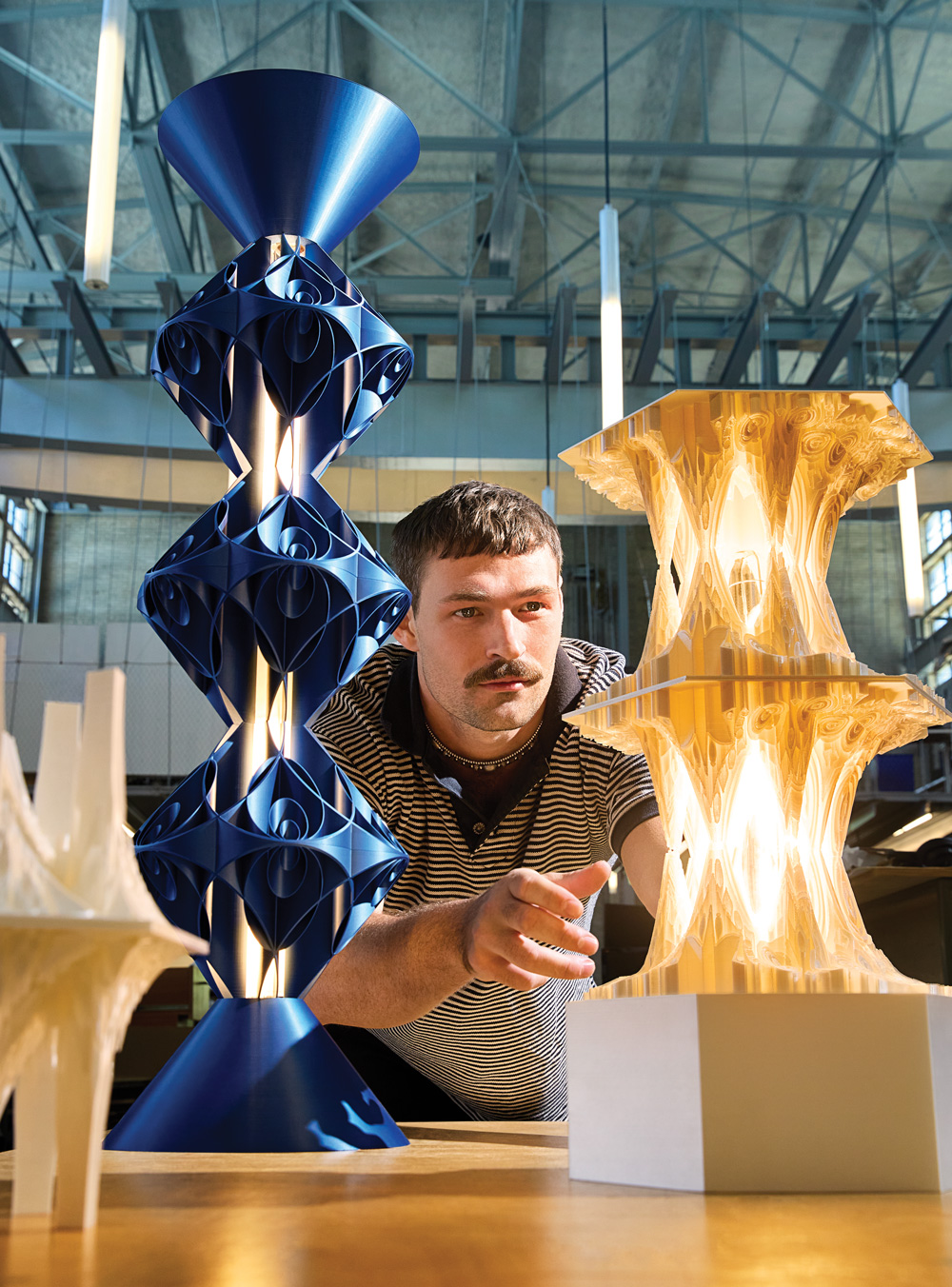
Photograph by Wedig + Laxton
There’s a glow emanating from the windows of Georgia Institute of Technology’s Hinman Research Building, and it’s cast by a collection of unusual geometric lamps. If you’re there at the right time, you might catch Sam Thurman using a 3D printer to create one based on his custom design script. Such 3D printers are typically used for industrial prototypes, says Thurman, a student at Georgia Tech’s Master of Science in Urban Design program, who also holds a master’s degree in architecture from the school. “But a few people are pushing them into the realm of high-concept sculptural art the way I am.”
Thurman grew up in a “progressive, cultural household” in Lexington, Kentucky, with a mother who was a therapist and a father who worked in public television. After high school, where he excelled in science and math, he enrolled at the University of Cincinnati and majored in architecture to blend his mathematical talent with his desire for creativity.

Photograph by Wedig + Laxton
While in college, Thurman experienced what he now calls a personal transformation: He found himself backing away from parties and friends to follow a more internal path. Reflecting on topics such as religion, spirituality, and technology, he concluded that we can use technology responsibly to enhance our lifestyles. “Everything is a tool, and it depends on how you use it,” he says. “We can avoid being consumed by it.”
Thurman decided to harness computers for creative ends. The lamps—equal parts art form, tech, and useful home decor—began as a class project during his architecture master’s program. He came up with the design script, a special code that tells the 3D printer which parts to make. Thurman continued to work on the script for the next year, using the campus 3D printers to bring the designs into reality.
“At first, I just experimented with the forms,” he says. “But then I became obsessive.” By 2024, the first lamp—the “OG prototype”—emerged.
Each of the lamps displays radial symmetry like a starfish or a snowflake: a towering center with forms repeating up and down the sides in a mathematically perfect pattern. They are made from recycled polylactic acid, a biodegradable plastic made from corn or sugarcane, which gives them a pearly iridescence. The lighting component is simple on purpose, Thurman says, consisting of wiring through the bottom and an 11-inch bulb. Switched on, the lamps give off cozy glows in various colors.
Each lamp can take as long as six weeks to complete, depending on its size and complexity: Thurman prints forms from the design script and assembles them into a finished lamp. He describes the process as fully immersive; usually he works at night after class, the gym, and other obligations. He keeps the workroom dim, except for the glow of the operating 3D printers, and tends to listen to “atmospheric” music.
“There are times I forget to eat completely,” he says of the process. “It’s not about comfort. It’s about building something beyond myself, yet of myself. Occasionally, a friend will stop by and just sit, watching the forms emerge.”
This month, he’ll exhibit his lamps for the first time at Memento Gallery, with private showings through early July. In October, they’ll be on view in Concourse E at Hartsfield-Jackson International Airport as part of the ATL Airport Art program.

Photograph by Wedig + Laxton
In the future, Thurman wants to explore swapping 3D technology for handcrafted lamps made of metals, gems, and translucent materials. He also plans to collaborate on designs with Andreas Palfinger, a Fulbright scholar at Pratt Institute in New York: “We’ll be working on a chandelier and combining our designs,” he says. He’s also at work on a related project that uses artificial intelligence–powered scripts to design sculptural furniture pieces, which artisans then construct.
Thurman, whose ultimate goal is to establish himself as a blue-chip fine artist, acknowledges that his work lives at an unusual intersection between technology and art. Are lamps created with AI-inspired design and formed on a 3D printer—which makes them easier to reproduce—less like high art than the handmade lamps of old? Perhaps, he muses.
“Art is about the process and the emotion of things, which makes the mechanical
part interesting,” he says. “But it needs a narrative.”
This article appears in our June 2025 issue.
Advertisement




